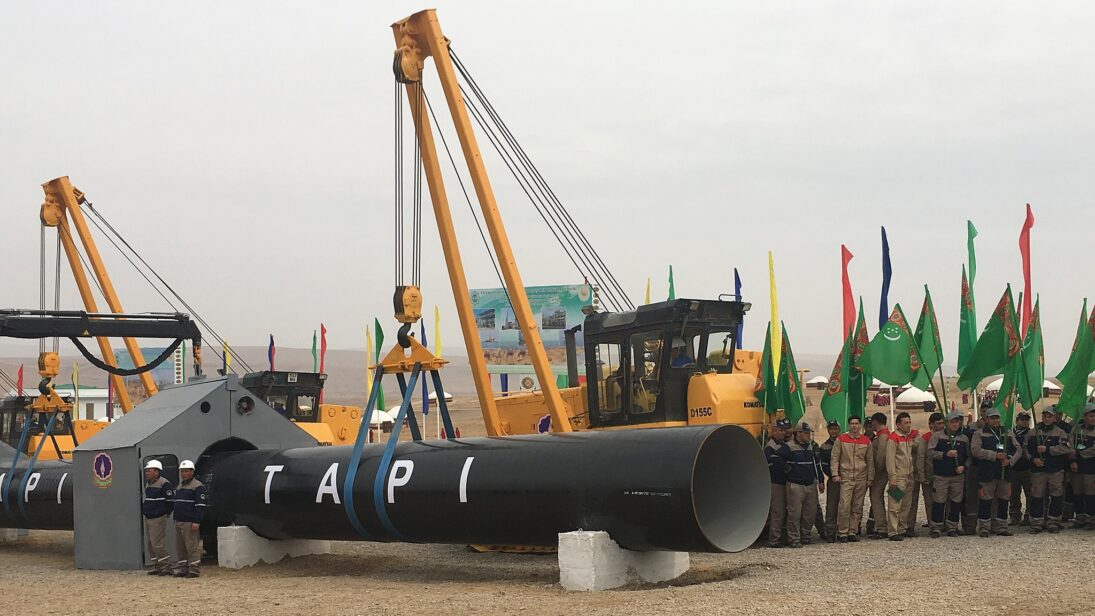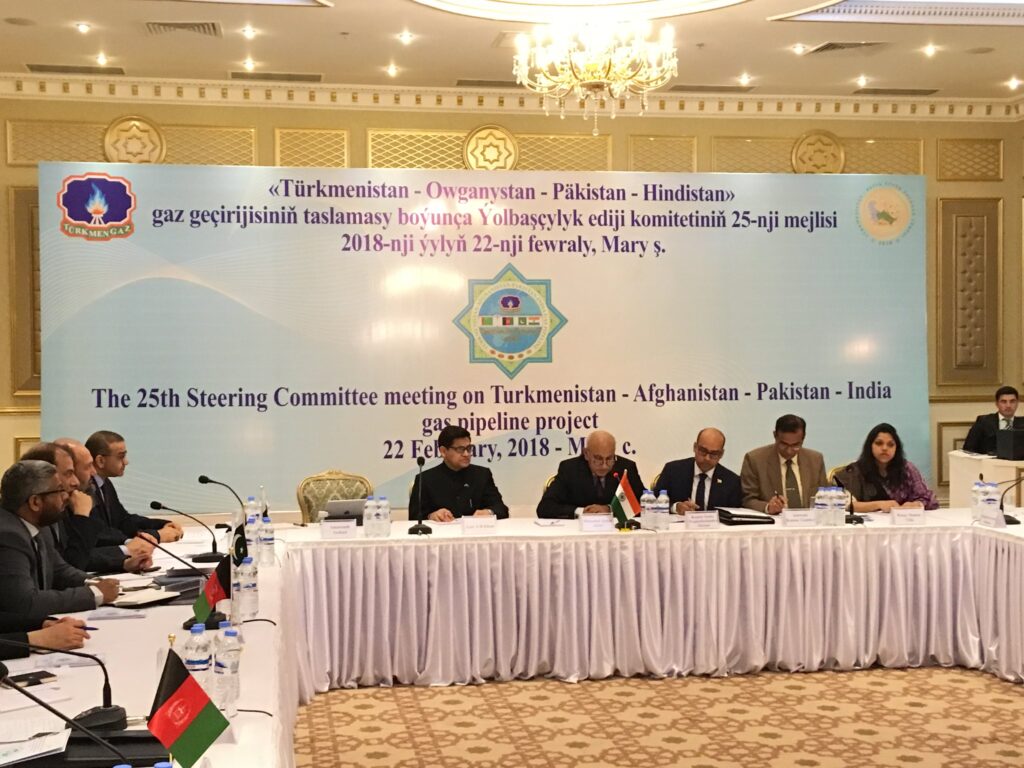
by Bantirani Patro
On September 11, 2024, the Taliban regime in Afghanistan declared a public holiday in Herat to mark the resumption of work on the Turkmenistan-Afghanistan-Pakistan-India (TAPI) gas pipeline. At the inauguration ceremony, Taliban chief Mohammad Hassan Akhund and President Serdar Berdimuhamedov of Turkmenistan emphasized the pipeline’s benefits to not just the participating countries but also the entire region.
Yet, notwithstanding this latest development, it is unclear whether India and Pakistan will join Turkmenistan and the Taliban regime with equal vigor in reviving the long-stalled TAPI project. For years, India has expressed several concerns regarding the safety and security of the project on top of its financial viability. Tensions between India and Pakistan have also served as an impediment. But given the evolving geopolitical situation in its neighborhood, New Delhi would gain several strategic and economic benefits from the TAPI project, and it should therefore take the lead in bringing the pipeline to fruition.
Shared Benefits
The TAPI pipeline was conceived to run for 1,814 kilometers, starting from the Galkynysh gas field in Turkmenistan, which is among the world’s largest natural gas fields. From Turkmenistan, the pipeline is supposed to traverse through Herat and Kandahar in Afghanistan, and Quetta and Multan in Pakistan, before terminating in Fazilka in Indian Punjab, abutting the India-Pakistan border. The project costs an estimated USD $10 billion and is expected to export 33 billion cubic meters of natural gas from Turkmenistan each year over a period of 30 years. Out of this total output, India and Pakistan would each receive 42 percent, with the remaining 16 percent going to Afghanistan.
In theory, the pipeline project promises to be a win-win situation for all nations on board. Turkmenistan would benefit from diversified gas exports and a reduction in its overreliance on the Chinese market. Afghanistan is expected to gain local employment opportunities, infrastructural benefits, and improved access to energy. In addition, estimates say that the country could earn anywhere from USD $450 million to USD $1 billion in transit fees and other revenues. The Taliban also hopes that the project will give it greater global legitimacy and help establish Afghanistan as a stable destination for investment. For Pakistan, the project could represent relief from soaring energy prices, which have driven street protests amid an economic downturn. And finally, for India, natural gas received through the pipeline could prove critical in diversifying New Delhi’s energy mix and achieving its goal of net-zero emissions by 2070.
Yet, despite these benefits, the TAPI project has failed to get off the ground for several years. Although the roots of the project harken back to the mid-1990s, its present iteration was conceived in the early 2000s. In 2010, the four participating countries concluded an Inter-Governmental Agreement and a Gas Pipeline Framework Agreement. These were followed by several additional agreements and ceremonial events. However, in the years that followed, a series of security crises, hidden costs, and other logistical constraints delayed the pipeline’s completion repeatedly. Turkmenistan previously announced that it had completed construction on its segment of the pipeline, but construction on the rest of the pipeline has stalled time and again, and there is still no definitive timeline for the completion of the project as a whole.
Why the Project Has Stalled
Over the last few years, the progress of the TAPI pipeline has been stymied by the sundry security crises plaguing the region — in particular, the internal strife in Afghanistan. In the wake of the Taliban’s ascent to power, analysts say that the situation in Afghanistan has turned relatively stable, and according to the Global Terrorism Index, the country no longer ranks as the most terrorism-affected in the world. To further assuage concerns, in 2022, the Taliban pledged to raise a security force to protect the pipeline. Yet, despite these developments, militant groups continue to operate in the country, and policing the entire pipeline remains inherently impractical. Additionally, there has also been a sharp uptick in terror attacks in Pakistan, and in particular, its Balochistan province — a volatile region through which the TAPI pipeline would pass.
In addition to security concerns, the TAPI project has also faced financial uncertainties. The Asian Development Bank has offered its good offices, and as TAPI’s transaction advisor, it helped establish the pipeline consortium — the TAPI Pipeline Company Limited (TPCL). But Turkmengaz — Turkmenistan’s state-owned gas company, which holds an 85 percent stake in the TPCL — has had limited experience with a multinational project of this scale and has hence struggled to attract high-end investors.
There has also been limited investment in the project from major powers. While the United States once hailed the project as a “magic glue” that would bind the region’s warring factions, it has not committed any funding to it. Both Russia and China have shown interest in joining the TAPI project at different points in time but have taken no substantive steps toward it or committed any contributions.
Beyond these challenges, India — the largest participant in the project — has dragged its own feet for years. In 2018, India had flagged concerns that the price of natural gas supplied through the pipeline would be nearly double that of domestically produced natural gas. Consequently, New Delhi had sought to renegotiate the TAPI Gas Sales and Purchase Agreement. In the years since, the TAPI project has faced more serious headwinds from tensions between New Delhi and Islamabad, whose bilateral ties, albeit relatively stable, have now settled into a mode of minimum engagement and maximum detachment. In particular, New Delhi worries that if it depends on the pipeline for its energy supply, it would grant Pakistan leverage during a future conflict. In such a scenario, Islamabad could simply switch off the gas supply and squeeze New Delhi.

India Has Much to Gain By Leading TAPI to Fruition
Despite its strategic concerns, however, ongoing tensions with Pakistan should not discourage New Delhi from taking the lead in completing the TAPI pipeline. Much like the Taliban regime, which has promised to raise a force to protect the TAPI pipeline due to its internal security situation, Pakistan’s economic need for the implementation of the project may similarly incentivize and possibly compel its establishment to confront domestic elements antithetical to the project. In that sense, benefits accrued from the TAPI pipeline could potentially serve as a confidence-building measure between India and Pakistan.
A possible thaw with Pakistan may be especially critical for New Delhi at a time when it appears to be losing ground in its immediate neighborhood, following the fall of allies such as former Bangladeshi Prime Minister Sheikh Hasina. To that end, the TAPI project presents an especially fertile platform for New Delhi because engaging indirectly with Islamabad for the purpose of implementing the pipeline would carry far less political risk for Indian Prime Minister Narendra Modi than initiating a bilateral dialogue directly with Pakistan.
Even if a potential reset with Pakistan proves elusive, the TAPI initiative may still be New Delhi’s best bet at gaining access to the resource-rich and geographically critical Central Asian region. Over the years, India has tried to deepen its ties with Central Asia while circumventing Pakistan, but this effort has seen limited success. For instance, New Delhi had envisioned its participation in the International North South Transport Corridor (INSTC) as a way to bypass Pakistan. But driven by strategic and geopolitical imperatives, Russia recently invited Pakistan to join the INSTC. Such instances show that India cannot escape its geography and may have little choice but to engage with multilateral initiatives that include Pakistan in order to achieve its goal of greater integration with Central Asia.
Under the circumstances, India should not forgo the strategic influence it could derive by breathing new life into TAPI. There are already signs of potential competition. Interest and involvement from Russia and China could expand the project’s feasibility, but it might also prevent India from exercising leverage and authority over the direction of the project. India would similarly lose influence in its extended neighborhood if the other TAPI countries decide to proceed without its participation.
India should therefore cast aside its cautious wait-and-watch policy toward the TAPI pipeline and take the lead in shaping its future. Despite the fact that most of the pipeline does not pass through India’s territory, New Delhi’s geopolitical and geoeconomic heft far surpasses that of the other TAPI participants, and its active involvement and leadership could therefore speak well for the project’s viability and consequently attract more investors. Washington too has an interest in encouraging India’s leadership. As the closest U.S. strategic partner among the TAPI participants, New Delhi’s role may be especially crucial in protecting Washington’s interests, especially given Russian and Chinese interest in the project.
The TAPI pipeline would be a boon in multiple ways for all countries involved, but its success would require India’s proactive participation and leadership. India should not lose out on this opportunity to expand its strategic influence simply due to Pakistan’s presence. India has recently shown an ability to engage with multilateral fora and initiatives that involve Pakistan. Most recently, for instance, Indian External Affairs Minister S. Jaishankar traveled to Islamabad for a Shanghai Cooperation Organization meeting — the first visit to Pakistan by an Indian foreign minister in nearly a decade. New Delhi should treat the TAPI project in the same spirit and use it to demonstrate its capacity for regional stewardship.
source : southasianvoices
